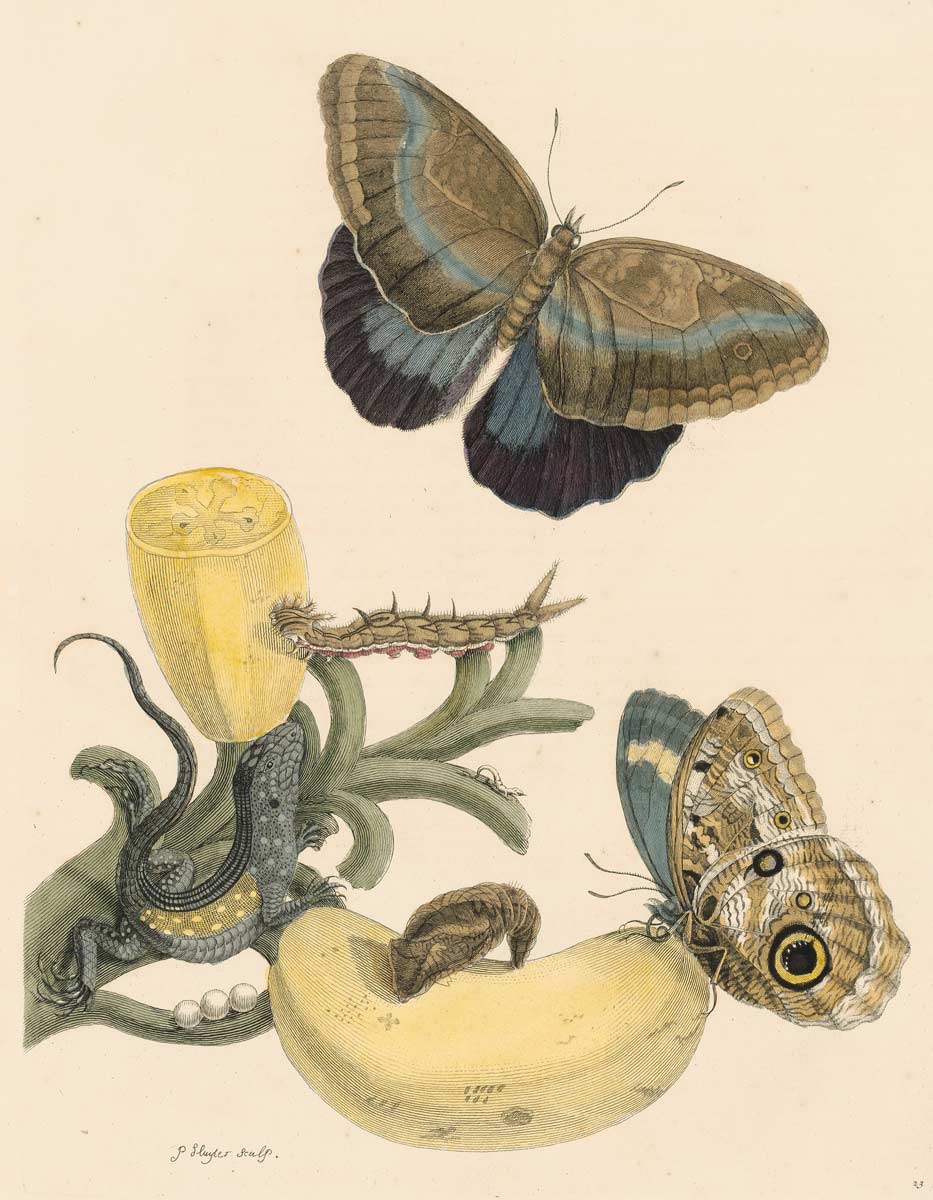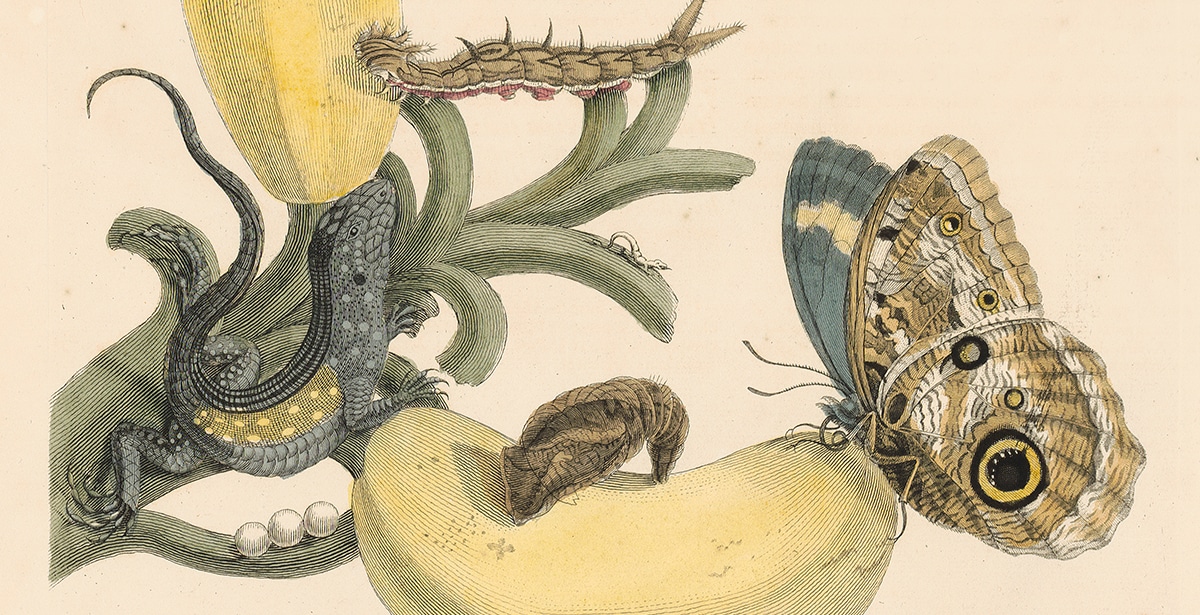Botanical Art
Merian’s Metamorphosis of the Insects of Suriname
Visualizing Contained Ecosystems and Insect Development
Throughout her work Metamorphosis of the Insects of Suriname, Maria Sibylla Merian’s sketches encapsulate ecological compositions that illustrate the life cycle, habitats, and diets of insects and amphibians she encountered on her voyage in South America.
Venturing into the uncharted jungles and rainforests of Dutch Suriname at the age of 52, and accompanied only by her daughter, Merian displayed a remarkable proclivity for operating outside the normative expectations for artists, entomologists and women of her day. Armed with her sketching and painting utensils, Merian meticulously studied the metamorphosis of insects and amphibians for two years before returning to her home in Amsterdam where her work was published. In an age where metamorphosis was not fully understood, and where theories of spontaneous generation were conjured to account for the seemingly unexplainable appearance and mutation of certain insects, Merian’s work was a fundamental contribution to the development of entomology and morphology.
Ecological Microcosms
In Merian’s prints, the interplay of negative and positive space creates a network of intertwined forms that relay an ecology in microcosmic terms. The interdependence of botanical and zoological life is visually evinced through the binding tendrils of vines, the lizards that feed on fruiting trees, and the chrysalides that cling to leaves and branches. Most significantly, Merian’s work charts the maturation and metamorphosis of insects in a manner that encapsulates the subject’s development and thus presents time as a composite. As a result, her prints read as a continuous narrative in which the same subject, whether it’s a moth, spider, or frog, can be viewed in several stages of its development simultaneously, from egg to adulthood.

Merian 1726, Pl. 3, Soursop

Merian 1726, Pl. 23, Lizard & Banana
Take for example Merian’s engraving Lizard & Banana, Pl. 23 , from the 1726 publication of Metamorphosis. Presented in rhythmic continuity, we see the complete life cycle of the Teucer Owl Butterfly taking place against its habitational backdrop, the banana stalk, and in the company of a Rainbow Whiptail Lizard. In its nascent state, the Teucer Owl caterpillar feeds on the flesh of the banana, which is artistically truncated to expose the inner scaffolding of the fruit. The insect’s second and third stages of development are delineated on a second banana at the central lower portion of the print. Here we see the enshrouded pupa nesting on the fruit next to a newly emerged butterfly. Our eye is guided in a rhythmic circuit about the print following the butterfly’s progressive stages of development. The butterflies fourth and final state of being concludes with its apotheosis as mature adult gliding at the topmost portion of the print. Rendered in shades of blue and brown, the butterfly acts as the denouement to the narrative taking place below.
To further buttress the theme of morphological evolution in this print, Merian includes the Rainbow Whiptail Lizard captured in three stages of being. First, three pearl-like eggs line the banana stalk below the mature lizard’s extended claw to indicate the origin of the creature. Second, the hatched lizard, minute and barely visible, scurries along the banana bough like a fiending dragon. Lastly, the fully grown lizard languidly grasps onto the banana tree for support as it basks in its maturity. The metamorphosis of the two species, butterfly and lizard, run parallel as each bends and sways to the dictate of time.
Historical Context
It is necessary to elucidate the context in which Merian lived and worked in order to understand the magnitude of her achievements, and the influences of her cultural context on her work and worldview. Born in 1647 in Frankfurt, Merian grew up immersed in art. Her father owned a printing press which, in addition to familiarizing Merian with the printing process, also exposed her to a great number of books and worldviews beyond her immediate surroundings. Publications like Sir Walter Raleigh’s The Discoveries of the Large Rich and Beautiful Empire of Guiana (1599) which presented South America as a place of wealth, bounty, exotica, and mythical intrigue, would have crossed her path and likely nurtured her desire to travel beyond her native land. Likewise, Ovid’s Metamorphosis ( 8 CE) was printed in her father’s press and may have prompted her interest in morphology. In fact, as an adult, Merian moved to Amsterdam at a time when the Dutch trading enterprise was at its zenith. In a city of ports, Merian’s life would have been saturated with the flow of exotic and novel goods that permeated the local markets. For these reasons, the idea of traveling abroad to sketch insects may not have seemed so foreign.

Portrait of Maria Sibylla Merian
Engraved by Jacob Houbraken, after Georg Gsell, 1708 – 1780, Rijksmuseum

Merian 1726, Pl. 49, Lantern Fly with Pomegranate Flower
Creative Approach
Merian’s Dutch homeland also influenced her approach to the subject matter she chose to represent in Suriname. For example, the Lantern Fly was a foreign and highly sought-after specimen in Amsterdam, and, in her enthusiasm to paint and understand the new and intriguing insect, Merian conflated two specimens into one. In Lantern Fly with Pomegranate Flower, pl. 49, she mistakenly presents a cicada as the premature form of the lantern fly, wherein fact, the two are separate and distinct species. In this way, Merian’s work not only elucidates the development of an insect but also of a discipline. Her misrepresentation of the developmental stages of the lantern fly allows us to simultaneously witness the unfurling of the field of entomology and the unavoidable mistakes that are the necessary foundation of any discipline.


While in Suriname, Merian’s process included collecting and observing specimens, before recording the results through sketches and note-taking. It was not until she returned to Holland with her specimens in tow that she began composing her watercolor compositions as they were to appear on the printed page. When her project Metamorphosis of the Insects of Suriname was finally brought to fruition in 1705, it featured pages of lusciously colored engravings accompanied by her written observations. The print medium lends itself to the representation of the subject matter because of the highly intricate, delicate lines that can be achieved through engraving. As a result, butterflies appear to flit about the page, and leafy stems seem to sway in response to their insect inhabitants. Additionally, the pressure of the engraved copper plate as it is run through the printing press leaves behind a slight embossment on the paper that adds to the tactility and animation of the insects. This vivacity and palpability are further amplified by the hand application of color to each engraved image. To this day, Merian’s prints are marvelous in the way they make time appear composite, and successive stages of growth are presented as occurring simultaneously. In this way, the development of the various insects appears to be encapsulated in an intimately intertwined and codependent ecological microcosm.






The insect figures, often with an ecological content, bring together art and science and bring Maria Sibilla’s great legacy to entomologists and scholars natural environment of all times.